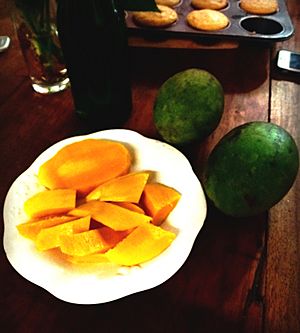Mangifera caesia facts for kids
Quick facts for kids Mangifera caesia |
|
|---|---|
 |
|
| Mangifera caesia fruits from Lapuyan, Zamboanga del Sur, Philippines, prepared in a typical Filipino fashion for a "merienda" or snack. | |
| Conservation status | |
| Scientific classification | |
| Genus: |
Mangifera
|
| Species: |
caesia
|
Mangifera caesia is a type of flowering plant that belongs to the cashew family. You might know it as jack or white mango. It's a close relative of the regular mango! This plant is grown a lot in countries like Indonesia, Malaysia, Singapore, Brunei, Papua New Guinea, and the Philippines.
In 1999, Mangifera caesia was even featured on a Malaysian postage stamp as part of a special series about rare fruits.
Contents
What it's Called
Mangifera caesia has many different names depending on where you are. This is because different languages and cultures have their own words for it.
- In Malay language, it's called binjai.
- In Balinese language or Dusun language, it's known as wani.
- In Thai language, people call it yaa-lam.
- In the Filipino language, it can be bayuno, baluno, or belunok.
- In Cebuano language or Sabah language, it's mangga wani.
- And in Subanen language, it's called gwani.
About the White Mango Tree
These trees like wet, low-lying areas, usually below 450 meters (about 1,476 feet) above sea level. They need a lot of rain and are often found near marshes or rivers. You won't usually see them deep in thick forests.
A white mango tree can grow very tall, up to 30 meters (about 98 feet)! It has a thick top part, called a crown, with round-shaped leaves. The flowers are small, about 0.7 cm (0.3 inches) long, and can be purple or pink. They have five small leaf-like parts called sepals.
The fruit is large and can be eaten. It's shaped like an oval, about 10 to 15 cm (4 to 6 inches) long and 6 to 8 cm (2.4 to 3.1 inches) wide. The skin is thin and brown with darker spots. Inside, the flesh is yellowish-white and soft. It has a strong smell and tastes sweet and sour.
People believe the binjai tree first came from the island of Borneo. However, it is now grown in many other places because its fruit is so popular. It's one of the most common and important Mangifera trees in western Malaysia, where many farmers grow it. It's also widely grown in Bali, Sumatra, and Borneo.
Life Cycle and Fruit Production
This amazing tree produces thousands of fruits! The fruits become ripe about three months after the flowers bloom. They usually ripen during the rainy season.
The white mango tree is a deciduous tree, which means it sheds its leaves. Before new leaves and flowers grow, the tree stands tall and bare. It sheds large scales that cover its twigs and flower clusters.
How New Trees Grow
You can grow new white mango trees in a few ways. One common way is from seeds. Another method is called marcotting, where a branch is encouraged to grow roots while still attached to the parent tree.
It's also possible to join a young white mango plant (called a seedling stock) to a branch of a mature tree. This is done by a method called inarching, where the potted young plant is attached to a twig of the mother tree.
When a white mango tree grows to its full size, it needs a lot of room. It needs about 12 to 16 meters (about 39 to 52 feet) of space in every direction.
How People Use the Fruit
The fruit of the Mangifera caesia is very versatile! You can eat it fresh, or it can be preserved or cooked. Some people like to eat it by dipping it in chili and dark soy sauce.
In Bali, the fruit is used to make creamy local juices. It's also an ingredient in a spicy base for sambal (a chili sauce) that is often eaten with river fish. You can even use it to make pickles! Besides the fruit, the wood from the tree is used for light construction projects.
In Brunei, where it's called binjai, the fruit is used to make a dipping sauce called cacah. This sauce is eaten with ambuyat, a dish made from sago that is considered the country's national dish.
Nutritional Goodness
The binjai fruit is not just tasty, it's also good for you! Here's what 100 grams (about 3.5 ounces) of binjai fruit contains:
- Water: 86.5 grams
- Protein: 1 gram
- Fats: 0.2 grams
- Carbohydrates (including fibers): 11.9 grams
- Ash: 0.4 grams
- Thiamine: 0.08 milligrams
- Beta-carotene: 0.005 milligrams
- Vitamin C: 58 milligrams
- Total Energy: 200 kilojoules (about 48 calories)
A Small Warning
The sap, which is the liquid inside the Mangifera caesia tree, can sometimes cause skin rashes or irritation. The sap from unripe fruits can also cause irritation, so it's good to be careful when handling them.


